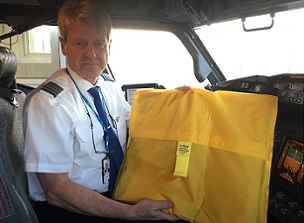 A lithium battery fire can quickly fill the confined space of an aircraft passenger cabin with toxic smoke
A lithium battery fire can quickly fill the confined space of an aircraft passenger cabin with toxic smoke
 All these personal electronic devices are powered by lithium batteries
All these personal electronic devices are powered by lithium batteries
 A pilot with an AvSax lithium battery fire containment bag
A pilot with an AvSax lithium battery fire containment bag
One of the main dangers on board passenger aircraft these days is lithium battery fires because they burn so intensely and are very difficult to put out.
Pre-flight safety briefings now include a warning to passengers to alert the crew immediately if any of their personal electronic devices start to overheat or slip down and get lost in the seat.
This is because all these devices - including mobile phones, laptops, iPads, vapes and even earphones – are powered by lithium ion batteries which can go faulty, overheat and catch fire.
If a device gets lost in the seat and the seat is moved to try to find it the device it could get crushed, causing the battery to become damaged and catch fire.
When lithium batteries overheat or are damaged they go into thermal runaway and when this happens one cell in a battery overheats it can produce enough heat – up to 900°C (1652°F) – to cause adjacent cells to overheat.
The heat generated by chemical reactions inside the battery causes even more heat, leading to a continuous rise in temperature. This can result in the battery venting and releasing toxic flammable gases, exploding or catching fire and because they burn at such a high temperature, they are very difficult to put out.
Even more worrying, lithium-ion battery fires are prone to reigniting because the lithium salts in the battery are self-oxidizing, which means that they can’t be starved of oxygen like a traditional fire.
This is why airlines ban people from putting anything powered by a lithium battery or the battery themselves in luggage that has been checked in and goes in the aircraft hold.
A lithium battery fire burns with such fierce intensity that it can quickly take hold and spread to an extent the automatic fire extinguishers in the hold would struggle to put it out, leading to potential catastrophic consequences.
Chief Michael O’Brian, who chairs the International Association of Fire Chiefs’ Lithium-Ion Battery Committee based in the USA, says: “The speed at which things catch fire now has become drastically faster than we ever thought.
“We used to say fire was fast, like if your couch caught on fire, it was untenable in three minutes. Now with lithium-ion, it’s untenable in 20 seconds.”
There have been 485 verified lithium battery incidents recorded by the Federal Aviation Administration in the USA from March 2006 to April 2024 but figures have rocketed in recent years and have been running at an average around one a week since 2017.
These figures are just for the USA which suggests hundreds more incidents have happened elsewhere in the world but have never been reported. No other regulatory authority releases lithium battery incident figures, including the Civil Aviation Authority in the UK.
AvSax are designed to continually cool an overheating battery but are made from military grade material so should the battery explode it will be contained within the bag.
In its guidance the CAA states: “Since the development of the International Civil Aviation Organization (ICAO) guidance on dealing with an in-flight battery fire, new products designed for use in response to lithium battery thermal runaway events have become available.
“Products which provide both a cooling and containment capability are typically more aligned to the existing ICAO guidance as when used they are filled with water or other non-flammable liquid to act as a cooling agent.
“After knocking down flames it could conceivably take just a couple of seconds for a personal electronic device to be placed inside a containment bag, allowing it to be moved to a place of safety. Passengers could then return to their seats, mitigating potential unrelated safety hazards such as injury in the case of severe turbulence. Equally, the effect on flight crew in carrying out their duties following an event on the flight deck would be minimised.”
AvSax are now on board around 16,750 aircraft operated by more than 100 airline companies worldwide, including some of the best-known names in the aviation industry. It also means that if an incident happens on a plane the AvSax will deal with it so the plane can continue to its final scheduled destination without having to make an emergency landing which causes huge expense for the airline and immense disruption to passengers.
AvSax won the Queen’s Award for Enterprise in the UK for their innovation and were devised by Environmental Defence Systems Ltd based in Huddersfield, Yorkshire, England. The Queen’s Award is the highest accolade any business can get.
For more information on AvSax go to www.avsax.com